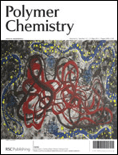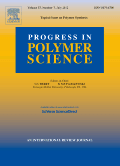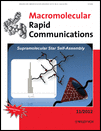
JOURNAL OF POLYMER SCIENCE
Scope & Guideline
Innovating Materials Science Through Polymer Research Excellence
Introduction
Aims and Scopes
- Polymer Synthesis and Characterization:
Research on various polymerization techniques, including controlled/living radical polymerization, ring-opening polymerization, and enzymatic polymerization, alongside the characterization of synthesized polymers using techniques such as NMR, GPC, and rheology. - Polymer Properties and Applications:
Investigating the mechanical, thermal, and electrical properties of polymers, along with their applications in fields such as electronics, biomaterials, and energy storage. - Supramolecular and Functional Polymers:
Exploration of supramolecular interactions, dynamic covalent bonding, and the design of functional polymers for specific applications, including drug delivery systems, self-healing materials, and stimuli-responsive polymers. - Nanocomposites and Hybrid Materials:
Research on the incorporation of nanomaterials into polymer matrices to enhance properties such as strength, conductivity, and thermal stability, as well as developing hybrid materials combining polymers with other classes of materials. - Environmental and Green Chemistry:
Focus on sustainable practices in polymer science, including the recycling of polymers, biodegradable materials, and the use of green solvents and processes in polymer synthesis.
Trending and Emerging
- Self-Healing and Recyclable Materials:
Increasing interest in the development of polymers that can self-repair or be easily recycled is evident. This trend responds to growing environmental concerns and the need for sustainable materials that can extend the lifecycle of polymer products. - Smart and Responsive Polymers:
There is a significant rise in research on stimuli-responsive polymers, including those that change properties in response to environmental triggers such as temperature, pH, or light. These materials have applications in drug delivery systems and adaptive materials. - Advanced Nanocomposites:
The incorporation of nanomaterials into polymer systems is a rapidly growing area, focusing on enhancing mechanical, thermal, and electrical properties, thus broadening the application of polymers in advanced technologies, including electronics and energy storage. - Biopolymers and Bioinspired Materials:
Research on biopolymers and bioinspired materials is on the rise, emphasizing sustainability and the development of materials that mimic natural processes or structures for applications in biomedicine and environmental management. - Machine Learning and Data-Driven Approaches:
The application of machine learning and data science in polymer research is gaining traction, with studies aiming to predict polymer behavior and optimize synthesis processes using computational models.
Declining or Waning
- Traditional Polymer Processing Techniques:
There has been a noticeable decline in papers focusing on conventional polymer processing methods, such as injection molding and extrusion, as researchers increasingly shift towards advanced processing techniques like 3D printing and electrospinning. - Basic Polymer Physics:
Research that primarily focuses on fundamental polymer physics, such as simple models of polymer behavior under stress or temperature, has decreased, likely as the field moves towards more complex and realistic modeling approaches incorporating molecular dynamics simulations. - Single-Polymer Studies:
Studies centered solely on single-polymer behavior, without considering the interactions within blends or composites, have waned as the field increasingly emphasizes the importance of polymer interactions and network formation.
Similar Journals

Polymer Reviews
Leading the dialogue in materials engineering.Polymer Reviews, published by Taylor & Francis Inc, is an esteemed journal dedicated to the intricate and evolving field of polymer science. With its ISSN 1558-3724 and E-ISSN 1558-3716, the journal has established a significant presence among researchers and practitioners alike, evidenced by its impressive categorization in the Q1 quartiles across multiple disciplines, including Biomedical Engineering, Materials Chemistry, and Renewable Energy. Since its inception in 2006 and continuing through 2024, Polymer Reviews has consistently aimed to advance the knowledge base of polymer applications and innovations, providing a platform for comprehensive review articles that stimulate further research and inspire practical solutions. The journal, ranking within the top percentile across several Scopus categories, underscores its impact and relevance in a rapidly developing scientific landscape. Though not an open-access journal, it remains a vital resource for those invested in the future of materials science and engineering.

POLYMER INTERNATIONAL
Transforming Ideas into Polymer InnovationsPOLYMER INTERNATIONAL is a leading journal in the field of polymer science, published by Wiley, one of the most esteemed scholarly publishers. With an ISSN of 0959-8103 and an E-ISSN of 1097-0126, this journal has been a pivotal platform for researchers since its inception in 1991, now extending its coverage until 2024. The journal boasts a commendable standing in various scientific domains, achieving a Q2 quartile ranking in Materials Chemistry, Organic Chemistry, and Polymers and Plastics as of 2023. Additionally, it holds impressive Scopus ranks, including Rank #47 in Organic Chemistry and Rank #40 in Polymers and Plastics, placing it within the top percentiles of its categories. Researchers, professionals, and students alike can benefit from its rich array of articles that contribute to the understanding and advancement of polymer technology and materials science. Although not an open access journal, POLYMER INTERNATIONAL remains crucial for disseminating high-quality research that drives innovation and development within the field.

Polymers
Driving forward-thinking research in polymer chemistry.Polymers is a premier journal published by MDPI, dedicated to advancing the field of polymer science and technology. This open-access journal, established in 2009, has quickly gained prominence in the academic community, serving as a vital platform for disseminating high-quality research articles, reviews, and communications in the realms of chemistry, polymers, and plastics. Based in Switzerland, with an impressive ranking in the Q1 quartile for both Chemistry and Polymer studies, Polymers boasts a significant impact factor, reflecting its rigorous peer-review process and esteemed editorial board. Researchers, professionals, and students alike benefit from the broad accessibility of content, allowing for a more extensive reach and engagement within the scientific community. As a key resource for the latest advancements and innovations in polymer research, Polymers continues to lead discussions, inspire collaborations, and foster the development of novel materials that shape various industrial applications.

Polymer Chemistry
Elevating Understanding in the World of PolymersPolymer Chemistry is a premier peer-reviewed journal published by the Royal Society of Chemistry, focusing on cutting-edge research and developments in the field of polymer science. With its ISSN 1759-9954 and E-ISSN 1759-9962, this journal has established a significant impact within the academic community, as evidenced by its impressive Q1 ranking in areas such as Biomedical Engineering, Organic Chemistry, and Polymers and Plastics. Over its convergence period from 2010 to 2024, Polymer Chemistry has become an essential resource for researchers, professionals, and students, showcasing innovative studies that advance the understanding of polymer behavior and applications. The journal does not currently offer open access, allowing for a traditional but rigorous peer-review process ensuring high-quality publications. For those engaged in the rapidly evolving disciplines of biochemistry and bioengineering, Polymer Chemistry serves as a vital platform for disseminating influential findings and fostering interdisciplinary collaboration in a global context.

POLYMERS & POLYMER COMPOSITES
Elevating Understanding of Composite MaterialsPOLYMERS & POLYMER COMPOSITES, published by SAGE Publications Ltd, is a prestigious journal dedicated to the exploration of significant advancements in the diverse fields of polymers, composite materials, and their innovative applications. With an ISSN of 0967-3911 and E-ISSN of 1478-2391, this journal plays a crucial role in the academic community, boasting an impressive ranking in the Q2 quartile across pivotal categories such as Ceramics and Composites, Materials Chemistry, and Polymers and Plastics in 2023. Positioned in the United Kingdom, it serves as a vital resource for researchers and professionals, providing insights into current trends and future directions in material science. Despite its availability not extending to Open Access, the journal aims to promote rigorous peer-reviewed research, thus fostering knowledge and collaboration among scholars. With publication convergence from 1993 to 2024, POLYMERS & POLYMER COMPOSITES stands as a cornerstone for those pursuing advanced understanding and excellence in material innovation.

Express Polymer Letters
Exploring the Frontiers of Polymer KnowledgeExpress Polymer Letters is a leading open-access journal published by BUDAPEST UNIVERSITY OF TECHNOLOGY AND ECONOMICS, focusing on the fast-paced realm of polymer science and engineering. With a broad scope that encompasses the interdisciplinary fields of Chemical Engineering, Materials Chemistry, and Organic Chemistry, the journal serves as a crucial platform for researchers and professionals dedicated to advancing knowledge and innovation in polymer-related disciplines. Since its inception in 2007, it has consistently provided high-quality, peer-reviewed research and has achieved a respectable impact within various categories, evidenced by its Q2 quartile rankings across multiple Scopus categories and its competitive standings in the field. The journal's dedication to open access ensures that research is widely disseminated, promoting transparency and collaboration within the academic community. Positioned to converge into the future, Express Polymer Letters remains an essential resource for cutting-edge studies and developments, with an anticipated convergence period extending through 2024.

POLYMER SCIENCE SERIES B
Advancing the Frontiers of Polymer ResearchPOLYMER SCIENCE SERIES B is a distinguished journal published by MAIK NAUKA/INTERPERIODICA/SPRINGER, dedicated to advancing knowledge in the fields of ceramics and composites, materials chemistry, and polymers and plastics. The journal, identifiable by its ISSN 1560-0904 and E-ISSN 1555-6123, spans a significant timeline from 1996 to 2024, reflecting its commitment to preserving and disseminating cutting-edge research in polymer science. With its current ranking in the Q3 category across relevant fields, it supports scholars and professionals in enhancing their understanding and application of polymeric materials. While it operates on a non-open access basis, the journal is pivotal for researchers seeking in-depth analysis and peer-reviewed studies. Located in the heart of the United States at 233 Spring St, New York, NY 10013-1578, POLYMER SCIENCE SERIES B serves as an essential resource for committed researchers, professionals, and students aiming to push the boundaries of polymer science.

PROGRESS IN POLYMER SCIENCE
Exploring New Dimensions in Polymer ApplicationsPROGRESS IN POLYMER SCIENCE is a prestigious academic journal published by PERGAMON-ELSEVIER SCIENCE LTD, dedicated to advancing the field of polymer science. With an ISSN of 0079-6700 and an E-ISSN of 1873-1619, this journal has established itself as a leading source of high-quality research since its inception in 1967. It ranks in the top quartile (Q1) across multiple categories including Ceramics and Composites, Materials Chemistry, Organic Chemistry, Polymers and Plastics, and Surfaces and Interfaces, reflecting its strong reputation and impact within the scientific community. The journal features rigorous peer-reviewed articles that not only contribute to theoretical advancements but also emphasize practical applications of polymer science in various industries. Although it is not an open-access journal, it remains accessible through institutional subscriptions and provides invaluable insights and data for researchers, professionals, and students alike. PROGRESS IN POLYMER SCIENCE is essential reading for anyone looking to stay abreast of the latest developments and innovations in this dynamic field.

MACROMOLECULAR RAPID COMMUNICATIONS
Unleashing Innovation in Polymers and PlasticsMACROMOLECULAR RAPID COMMUNICATIONS, published by WILEY-V C H VERLAG GMBH in Germany, is an esteemed journal dedicated to the rapid dissemination of high-quality research in the fields of materials chemistry, organic chemistry, and polymers and plastics. With a remarkable 2023 impact factor securing its place in the prestigious Q1 category across three key disciplines, the journal ranks impressively within the top quartiles of the Scopus metrics, standing at 36th in organic chemistry and 35th in polymers and plastics. Although the journal does not offer open access options, its informative depth and innovative research make it an invaluable resource for researchers, professionals, and students seeking to stay abreast of the latest developments in macromolecular science. Covering a broad spectrum of topics from fundamental research to applications, MACROMOLECULAR RAPID COMMUNICATIONS aims to foster collaboration and inspire further advancements within the scientific community.

IRANIAN POLYMER JOURNAL
Pioneering Knowledge in Polymer EngineeringWelcome to the Iranian Polymer Journal, an esteemed publication encompassing a rich history since its inception in 1996 and extending its scholarly reach up to 2024. Published by Springer from Switzerland, this journal stands out in the fields of Chemical Engineering, Materials Chemistry, and Polymers and Plastics, proudly holding a Q2 category ranking in each of these disciplines for 2023. With an ISSN of 1026-1265 and an E-ISSN of 1735-5265, the journal serves as a vital resource for researchers, professionals, and students, offering insights into polymer science and interdisciplinary applications. Although not an open-access journal, it presents an invaluable platform for high-quality research dissemination and robust peer-reviewed articles. With Scopus rankings indicating its respected position within the academic community, the Iranian Polymer Journal is committed to advancing knowledge and fostering innovation in polymer-related studies, making it an essential addition to your research library.